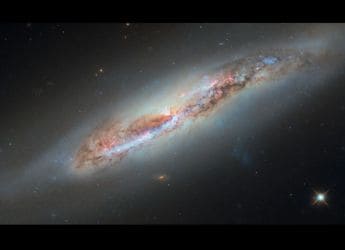- Home
- Science
- Science News
- NASA's 41 Year Old Voyager 2 Probe May Be Nearing Interstellar Space
NASA's 41-Year-Old Voyager 2 Probe May Be Nearing Interstellar Space

Photo Credit: NASA/ JPL-Caltech
This graphic shows the position of the Voyager 1 and Voyager 2 probes relative to the heliosphere
NASA's Voyager 2 probe that was launched in 1977 has detected an increase in cosmic rays that originate outside our solar system, indicating that it is near the interstellar space.
Once Voyager 2 exits the outermost layer of the heliosphere - the vast bubble around the Sun and the planets dominated by solar material and magnetic fields - it will become the second human-made object, after Voyager 1, to enter interstellar space, NASA said in a statement on Friday.
Voyager 2 is little less than 17.7 billion km away from Earth - or more than 118 times the distance from Earth to the Sun.
It is the only spacecraft to visit all four giant outer planet - Jupiter (1979), Saturn (1981), Uranus (198 ) and Neptune (1989).
Voyager scientists have been watching for the spacecraft to reach the outer boundary of the heliosphere, known as the heliopause.
"We're seeing a change in the environment around Voyager 2, there's no doubt about that," said Voyager Project Scientist Ed Stone from NASA's Jet Propulsion Laboratory in Pasadena, California.
Since late August, the "Cosmic Ray Subsystem" instrument on Voyager 2 has measured about a five percent increase in the rate of cosmic rays hitting the spacecraft compared to early August.
The probe's Low-Energy Charged Particle instrument has detected a similar increase in higher-energy cosmic rays.
"We're going to learn a lot in the coming months, but we still don't know when we'll reach the heliopause. We're not there yet - that's one thing I can say with confidence," Stone added.
Three other spacecraft are on interstellar trajectories. New Horizons is closing in on a Kuiper Belt Object more about a billion miles beyond Pluto on January 1, 2019.
Pioneer 10 and Pioneer 11 probes are no longer functioning, but will eventually travel into interstellar space.
In May 2012, Voyager 1 experienced an increase in the rate of cosmic rays similar to what Voyager 2 is now detecting.
"That was about three months before Voyager 1 crossed the heliopause and entered interstellar space," said NASA.
Get your daily dose of tech news, reviews, and insights, in under 80 characters on Gadgets 360 Turbo. Connect with fellow tech lovers on our Forum. Follow us on X, Facebook, WhatsApp, Threads and Google News for instant updates. Catch all the action on our YouTube channel.
Related Stories
- Samsung Galaxy Unpacked 2025
- ChatGPT
- Redmi Note 14 Pro+
- iPhone 16
- Apple Vision Pro
- Oneplus 12
- OnePlus Nord CE 3 Lite 5G
- iPhone 13
- Xiaomi 14 Pro
- Oppo Find N3
- Tecno Spark Go (2023)
- Realme V30
- Best Phones Under 25000
- Samsung Galaxy S24 Series
- Cryptocurrency
- iQoo 12
- Samsung Galaxy S24 Ultra
- Giottus
- Samsung Galaxy Z Flip 5
- Apple 'Scary Fast'
- Housefull 5
- GoPro Hero 12 Black Review
- Invincible Season 2
- JioGlass
- HD Ready TV
- Laptop Under 50000
- Smartwatch Under 10000
- Latest Mobile Phones
- Compare Phones
- OnePlus 15R
- Realme Narzo 90x 5G
- Realme Narzo 90 5G
- Vivo S50 Pro Mini
- Vivo S50
- OPPO Reno 15c
- Redmi Note 15 5G
- Redmi Note 15 Pro 5G
- Asus ProArt P16
- MacBook Pro 14-inch (M5, 2025)
- Infinix Xpad Edge
- OnePlus Pad Go 2
- OnePlus Watch Lite
- Just Corseca Skywatch Pro
- Acerpure Nitro Z Series 100-inch QLED TV
- Samsung 43 Inch LED Ultra HD (4K) Smart TV (UA43UE81AFULXL)
- Asus ROG Ally
- Nintendo Switch Lite
- Haier 1.6 Ton 5 Star Inverter Split AC (HSU19G-MZAID5BN-INV)
- Haier 1.6 Ton 5 Star Inverter Split AC (HSU19G-MZAIM5BN-INV)

















